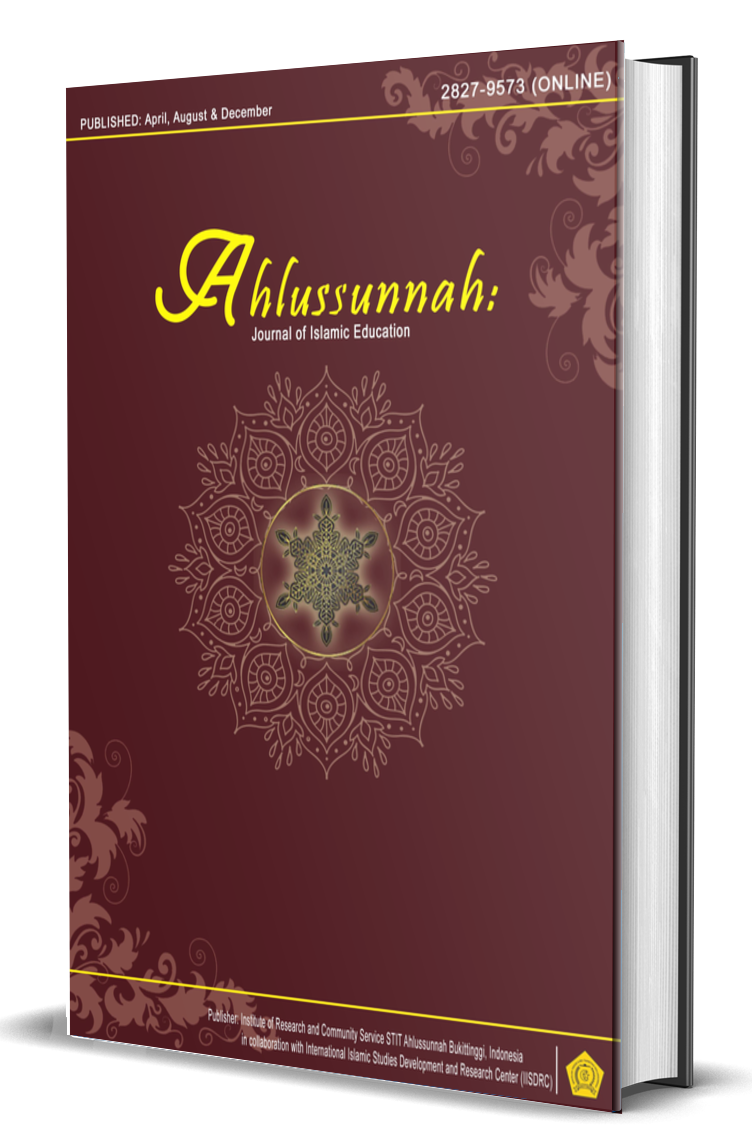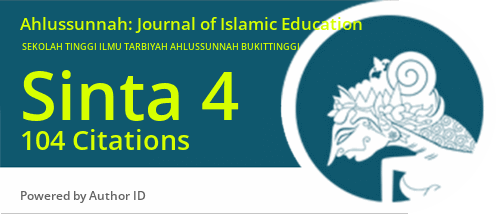Model of Islamic Religious Education for Children in Indonesia Minority Muslim Families
DOI:
https://doi.org/10.58485/jie.v1i3.183Keywords:
Model, Islamic religious education, Minority Muslim FamillyAbstract
This research aims to find out the form of Islamic religious education in Muslim families in Pasakiat Taileleu Village, then to find out the implementation of Islamic religious education in Muslim families in Pasakiat Taileleu Village and to find out the opportunities and challenges in the implementation of Islamic religious education in Muslim families in Pasakiat Taileleu Village. This research uses a descriptive qualitative approach. Data collection techniques: observation, interview, and documentation with data analysis through data reduction, data presentation, and conclusion drawing and verification. The results of this research analysis show that the Islamic religious education model in Pasakiat Taileleu Village includes a model of cultivating awareness, omission, wisdom, interaction, commands and prohibitions, advice, habits, punishment, and reward. The implementation of Islamic religious education in Muslim families in this village includes faith education tauhid, worship education, and moral education. Among the three types of education, the most prioritized is faith education because Muslims in this village are a Christian minority. The opportunities for implementing Islamic religious education in this village are the example of parents, the availability of parental time, the existence of Islamic religious education institutions, support from immigrants, the minimal influence of social media, the presence of preachers who serve, and peaceful social conditions. Meanwhile, the challenges in implementing Islamic religious education in this village are the majority Christian environment, the large number of tourists who come to travel, the parents' lack of knowledge about religion, poor economic conditions, limited religious information, and the lack of religious figures. The results of this research can provide guidance for minority Muslim families and perhaps also in other places, and can be used as initial data for future researchers in studying this problem in different contexts and issues.
Downloads
References
Arar, M., & Jung, C. (2021). Improving the indoor air quality in nursery buildings in United Arab Emirates. International Journal of Environmental Research and Public Health, 18(22). https://doi.org/10.3390/ijerph182212091
Arifin, Z. (2018). Al-Ghazali’s Thought of Islamic Education And it’s Relevance with the Modern Education. Khalifa: Journal of Islamic Education, 2(1), 1. https://doi.org/10.24036/kjie.v2i1.18
Berglund, J. (2013). Swedish religion education: Objective but marinated in Lutheran protestantism? Temenos, 49(2), 165–184. https://doi.org/10.33356/temenos.9545
Biggeri, M., & Santi, M. (2012). The missing dimensions of children’s well-being and well-becoming in education systems: Capabilities and philosophy for children. Journal of Human Development and Capabilities, 13(3), 373–395. https://doi.org/10.1080/19452829.2012.694858
Colorafi, K. J., & Evans, B. (2016). Qualitative Descriptive Methods in Health Science Research. Health Environments Research and Design Journal, 9(4), 16–25. https://doi.org/10.1177/1937586715614171
Daheri, M. (2022). Religious Moderation, Inclusive, and Global Citizenship as New Directions for Islamic Religious Education in Madrasah. Nazhruna: Jurnal Pendidikan Islam, 5(1), 64–77. https://doi.org/10.31538/nzh.v5i1.1853
Dittenber, D. B., & Gangarao, H. V. S. (2012). Critical review of recent publications on use of natural composites in infrastructure. Composites Part A: Applied Science and Manufacturing, 43(8), 1419–1429. https://doi.org/10.1016/j.compositesa.2011.11.019
Đurišić, M., & Bunijevac, M. (2017). Parental Involvement as a Important Factor for Successful Education. Center for Educational Policy Studies Journal, 7(3), 137–153. https://doi.org/10.26529/cepsj.291
E. Houser, N., Roach, L., R. Stone, M., Turner, J., & F.L. Kirk, S. (2016). Let the Children Play: Scoping Review on the Implementation and Use of Loose Parts for Promoting Physical Activity Participation. AIMS Public Health, 3(4), 781–799. https://doi.org/10.3934/publichealth.2016.4.781
Freudling, W., Romaniello, M., Bramich, D. M., Ballester, P., Forchi, V., García-Dabló, C. E., Moehler, S., & Neeser, M. J. (2013). Automated data reduction workflows for astronomy: The ESO Reflex environment. Astronomy and Astrophysics, 559. https://doi.org/10.1051/0004-6361/201322494
Gabler, S., Bovenschen, I., Lang, K., Zimmermann, J., Nowacki, K., Kliewer, J., & Spangler, G. (2014). Foster children’s attachment security and behavior problems in the first six months of placement: associations with foster parents’ stress and sensitivity. Attachment & Human Development, 16(5), 479–498. https://doi.org/10.1080/14616734.2014.911757
Gorecky, D., Schmitt, M., Loskyll, M., & Zühlke, D. (2014). Human-machine-interaction in the industry 4.0 era. Proceedings - 2014 12th IEEE International Conference on Industrial Informatics, INDIN 2014, 289–294. https://doi.org/10.1109/INDIN.2014.6945523
Harackiewicz, J. M., Rozek, C. S., Hulleman, C. S., & Hyde, J. S. (2012). Helping Parents to Motivate Adolescents in Mathematics and Science: An Experimental Test of a Utility-Value Intervention. Psychological Science, 23(8), 899–906. https://doi.org/10.1177/0956797611435530
Horan, A. P. (2017). Fostering Spiritual Formation of Millennials in Christian Schools. Journal of Research on Christian Education, 26(1), 56–77. https://doi.org/10.1080/10656219.2017.1282901
Ismail, I. (2016). Character Education Based on Religious Values: an Islamic Perspective. Ta’dib: Jurnal Pendidikan Islam, 21(1), 41–58. https://doi.org/10.19109/td.v21i1.744
Ismanto, S. D., Arbain, A., Helmi, H., & Syukri, D. (2021). Management Policy Analysis of Siberut Biosphere Reserve Mentawai Archepelago Distric West Sumatera Province. Andalasian International Journal of Agricultural and Natural Sciences (AIJANS), 2(02), 21–36. https://doi.org/10.25077/aijans.v2.i02.21-36.2021
Jennings, P. A., Frank, J. L., Snowberg, K. E., Coccia, M. A., & Greenberg, M. T. (2013). Improving classroom learning environments by cultivating awareness and resilience in education (CARE): Results of a randomized controlled trial. School Psychology Quarterly, 28(4), 374–390. https://doi.org/10.1037/spq0000035
Kalil, A., Ryan, R., & Corey, M. (2012). Diverging Destinies: Maternal Education and the Developmental Gradient in Time With Children. Demography, 49(4), 1361–1383. https://doi.org/10.1007/s13524-012-0129-5
Kaputra, S., Rivauzi, A., Jaafar, A., & Kakoh, N. A. (2022). Model of Tawhid Education in Children: An Ethnographic Study of the Tablighi Jama’ah Family in Indonesia. Khalifa: Journal of Islamic Education, 6(1), 120. https://doi.org/10.24036/kjie.v6i1.124
Koopmans, R. (2015). Religious Fundamentalism and Hostility against Out-groups: A Comparison of Muslims and Christians in Western Europe. Journal of Ethnic and Migration Studies, 41(1), 33–57. https://doi.org/10.1080/1369183X.2014.935307
Lam, T., & Yeoh, B. S. A. (2019). Parental migration and disruptions in everyday life: reactions of left-behind children in Southeast Asia. Journal of Ethnic and Migration Studies, 45(16), 3085–3104. https://doi.org/10.1080/1369183X.2018.1547022
Lassoued, Z., Alhendawi, M., & Bashitialshaaer, R. (2020). An exploratory study of the obstacles for achieving quality in distance learning during the covid-19 pandemic. Education Sciences, 10(9), 1–13. https://doi.org/10.3390/educsci10090232
McCambridge, J., Witton, J., & Elbourne, D. R. (2014). Systematic review of the Hawthorne effect: New concepts are needed to study research participation effects. Journal of Clinical Epidemiology, 67(3), 267–277. https://doi.org/10.1016/j.jclinepi.2013.08.015
Nasir, M., Hamzah, S. H., & Rijal, M. K. (2021). Anatomical Analysis of Islamic Religious Education Curriculum At General Higher Education in Indonesia. Ta’dib, 24(1), 53. https://doi.org/10.31958/jt.v24i1.2827
Nelson, S. K., Kushlev, K., & Lyubomirsky, S. (2014). The pains and pleasures of parenting: When, why, and how is parenthood associated with more or less well-being? Psychological Bulletin, 140(3), 846–895. https://doi.org/10.1037/a0035444
Novita, Y., Yulianti, V., Handayani, D., & Sugestina, E. (2022). Teachers Efforts to Improve Student Literacy in Islamic Cultural History Subjects. Khalifa: Journal of Islamic Education, 6(1), 102. https://doi.org/10.24036/kjie.v6i1.34
Nur Isnaini, U. K., Nyimasmukti, B. R., Rahawarin, Y., & Asrida, A. (2019). Revitalizing the Mosques Function as a Means of Forming Muslim Scholars and Students in Indonesia. Khalifa: Journal of Islamic Education, 3(2), 142. https://doi.org/10.24036/kjie.v3i2.29
Nurdin, H. (2020). Problems and Crisis of Islamic Education Today and in The Future. International Journal of Asian Education, 1(1), 21–28. https://doi.org/10.46966/ijae.v1i1.17
Pratama, A. B., & Azhari, M. F. (2020). Designing a Mobile Application Based on Gamification Method to Increase Muslims Reading Interest. Khalifa: Journal of Islamic Education, 4(1), 63. https://doi.org/10.24036/kjie.v4i1.35
Sahin, A. (2018). Critical issues in islamic education studies: Rethinking islamic and western liberal secular values of education. Religions, 9(11). https://doi.org/10.3390/rel9110335
Slama, M. (2017). A subtle economy of time: Social media and the transformation of Indonesia’s Islamic preacher economy. Economic Anthropology, 4(1), 94–106. https://doi.org/10.1002/sea2.12075
Turner, K. (2019). Convertitis and the struggle with liminality for female converts to islam in Australia. Archives de Sciences Sociales Des Religions, 186(2), 71–91. https://doi.org/10.4000/assr.45642
Downloads
Published
How to Cite
Issue
Section
License
Copyright (c) 2022 Purwanto Purwanto, Yosi Aryanti, Weti Susanti

This work is licensed under a Creative Commons Attribution-ShareAlike 4.0 International License.
Creative Commons Attribution 4.0 (CC BY)











